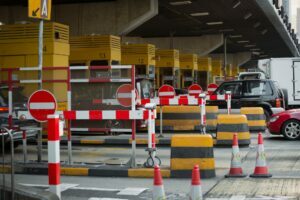Delameta.com – Along with the implementation of a contactless non-cash toll payment system based on the MLFF (Multi-Lane Free Flow) toll road system, toll users no longer need to stop at toll gates, let alone queue when making payments at toll gates.
So this certainly has a very good impact on the continuity of toll road performance which can be semi-automatic, as a result it can reduce the accumulation of vehicles when entering the toll road.
For those who are still unfamiliar with this latest toll road system, there will certainly need to be a lot more adjustments. Also remembering that this system has not been implemented evenly
What is MLFF?
MLFF or Multi Lane Free Flow is a toll road payment process that stops, meaning toll road users do not have to stop their vehicles at the toll gate for payment.
The technology applied at MLFF is the Global Navigation Satellite System (GNSS) which is a system that allows transactions to be carried out via smartphone and read via satellite.
This technology means that readers do not need to be in every place because they use a cable, which is different from radio frequency identification or RFID.
GNSS using a tool that is installed in the car. When the vehicle is at a toll road substation, the device will be read via a satellite system
MLFF Implementation Plan
By using Global Navigation Satellite System (GNSS) technology, the first phase of MLFF technology will be implemented on 40 toll roads in Indonesia spread across the islands of Java and Bali in 2022.
The investment value of the MLFF project is IDR 4.4 trillion, with a PT RITS concession period of 9 years from the date of commercial operation
Using electronic money has reduced transaction time to 4 seconds compared to manual transactions of 10 seconds. So, using MLFF certainly has huge benefits because it can reduce queue time to zero seconds.
The implementation will later run with a scheme of around 50% of the total toll booths at the toll gate will be used for MLFF, while 50% will be used for users who make conventional non-cash payments
Let’s support this sophisticated contactless payment technology or what is known as MLFF so that it can start running in Indonesia soon
Construction of Toll Roads in Indonesia
The construction of the initial toll road in Indonesia in 1975 was trialled by the government with funds from the government budget as well as foreign loans handed over to PT. Jasa Marga (parsero) Tbk, as capital
Next PT. Jasa Marga was tasked by the government to build a toll road using land funded by the government
Starting in 1987, the private sector began to participate in toll road investment as toll road operators by signing a concession agreement (PKP) with PT Jasa Marga.
Until 2007, 553 kilometers of toll lanes had been built and operated in Indonesia. Of the total length, 418 kilometers of the toll road is operated by PT Jasa Marga and the remaining 135 kilometers is operated by the private sector.
The toll road construction process again entered the acceleration phase starting in 2005. On June 28 2005, the Toll Road Regulatory Body was established as the toll road regulator in Indonesia. The continuation of 19 toll road projects whose construction was postponed in 1997 is being attempted again
But it doesn’t end there, of course until now both the government and the private sector will continue to build infrastructure for better progress in Indonesia.
There is also that so far the construction of toll roads will always be carried out using an approach namely full financing by the private sector, a private-public cooperation program (Public Private Partnership/PPP) and development financing by the Government with operation-maintenance by the private sector.
Conclusion
The MLFF Toll Road system is an excellent innovation for sustainable driving on toll roads, so it can make it easier for drivers not to have to think about balances or anything else.
This one could increase concentration while driving, remember Delameta Bilano.




